| Listing 1 - 10 of 10 |
Sort by
|
Book
ISBN: 0877627398 Year: 1990 Publisher: Basel Technomic
Abstract | Keywords | Export | Availability | Bookmark
 Loading...
Loading...Choose an application
- Reference Manager
- EndNote
- RefWorks (Direct export to RefWorks)
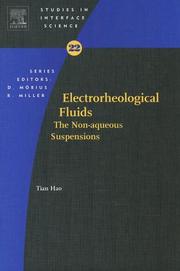
ISBN: 9780444521804 0444521801 0080455441 9780080455440 1280641843 9786610641840 Year: 2005 Publisher: Amsterdam ; Boston : Elsevier,
Abstract | Keywords | Export | Availability | Bookmark
 Loading...
Loading...Choose an application
- Reference Manager
- EndNote
- RefWorks (Direct export to RefWorks)
An electrorheological (ER) suspension is made from an insulating liquid medium embodying either a semi-conductive particulate material or a semi-conductive liquid material (usually a liquid crystal material). Since its mechanical properties can be easily controlled over a wide range (almost from a pure liquid to a solid), the ER fluid can be used as an electric and mechanical interface in various industrial areas, for example, in the automotive industrial for clutch, brake and damping systems and in robotic arm joints and hands. In addition, the ER technique can be used to fabricate advanc
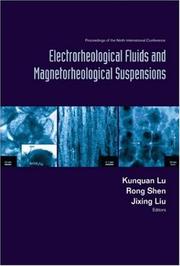
ISBN: 1281898279 9786611898274 9812702199 9789812702197 9781281898272 9812561226 9789812561220 6611898271 Year: 2005 Publisher: Singapore ; Hackensack, NJ : World Scientific,
Abstract | Keywords | Export | Availability | Bookmark
 Loading...
Loading...Choose an application
- Reference Manager
- EndNote
- RefWorks (Direct export to RefWorks)
This volume covers the most recent progress of research work on electrorheological (ER) and magnetorheological (MR) industrial applications related to controllable damping, ER/MR fundamental mechanisms, and understanding the potential of new classes of field responsive materials.The proceedings have been selected for coverage in: Materials Science Citation Index® Index to Scientific & Technical Proceedings® (ISTP® / ISI Proceedings) Index to Scientific & Technical Proceedings (ISTP CDROM version / ISI Proceedings) CC Proceedings - Engineering & Physical Sciences
Electrorheological fluids --- Rheology --- ER fluids --- Fluids
Book
ISBN: 1283433680 9786613433688 9814340235 9789814340236 9789814340229 9814340227 9781283433686 6613433683 Year: 2011 Publisher: Singapore ; Hackensack, N.J. : World Scientific,
Abstract | Keywords | Export | Availability | Bookmark
 Loading...
Loading...Choose an application
- Reference Manager
- EndNote
- RefWorks (Direct export to RefWorks)
This unique volume presents the scientific progress, state-of-art technology, and thrust areas to be focused in electrorheology (ER) and magentorheology (MR). In the last couple of years, this area produced significant impacts on automobile industry, bridge and building construction, aerospace industry, and defense industry. Recent innovation in this area lead to new technology, which has great impact on energy production and energy conservation. This book includes all papers presented at the 12th International Conference on ER Fluids and MR Suspensions, held in Philadelphia, USA, August 16 to
Electrorheological fluids --- Magnetic suspension --- Materials --- Electric properties --- Magnetic properties
Book
ISBN: 1281929727 9786611929725 9812777547 9781281929723 9789812777546 Year: 2002 Publisher: River Edge, NJ ; London : World Scientific,
Abstract | Keywords | Export | Availability | Bookmark
 Loading...
Loading...Choose an application
- Reference Manager
- EndNote
- RefWorks (Direct export to RefWorks)
This book contains up-to-date information on the state of the art of research and applications in electro- and magnetorheology. A total of 130 papers are presented in four sections. The first section is devoted to the various applications of ER and MR fluids, like polishing, microfluidics, vibration control, robots, shock absorbers and dampers, MR and ER valves. The second part deals with the experimental characterization as well as the theoretical prediction of the mesostructure resulting from field-induced phase separation. The dynamics of phase separation is also included in this section. T
Electrorheological fluids --- Materials --- Magnetic suspension --- Electric properties --- Magnetic properties
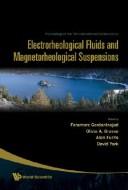
ISBN: 1281911704 9786611911706 9812771204 9789812771209 9789812771193 9812771190 9781281911704 Year: 2007 Publisher: Singapore ; Hackensack, NJ : World Scientific,
Abstract | Keywords | Export | Availability | Bookmark
 Loading...
Loading...Choose an application
- Reference Manager
- EndNote
- RefWorks (Direct export to RefWorks)
"ERMR 2006 included invited speakers, technical presentations, poster presentations, and a student paper competition. At the conference banquet, Dr. David Carlson of Lord Corporation addressed the conference attendees and gave a stirring speech on the history of ER and MR fluids, as well as current and future applications. A unique feature of the ERMR Conferences is that they comprehensively cover issues ranging from physics to chemistry to engineering applications of ER and MR materials held in a general session to enhance the interaction between the scientists and engineers. The sessions in ERMR 2006 were organized based into two Symposia: a) Materials and b) Applications. Topics covered in the Materials Symposium included: mechanisms, preparation, and characterization of ER and MR materials. Topics covered in the Applications Symposium included: ER and MR devices, control systems, system integration, and applications. This structure was implemented in order to enable interaction between attending scientists and engineers in both the Materials Symposium and the Applications Symposium, and to enhance the free flow of ideas, and the potential collaborative research opportunities."
Electrorheological fluids --- Magnetic suspension --- Magnetic levitation --- Suspension, Magnetic --- Magnetics --- ER fluids --- Fluids --- Rheology

ISBN: 9780444521804 0444521801 0080455441 9780080455440 9786610641840 1280641843 Year: 2005 Publisher: Amsterdam ; Boston : Elsevier,
Abstract | Keywords | Export | Availability | Bookmark
 Loading...
Loading...Choose an application
- Reference Manager
- EndNote
- RefWorks (Direct export to RefWorks)
An electrorheological (ER) suspension is made from an insulating liquid medium embodying either a semi-conductive particulate material or a semi-conductive liquid material (usually a liquid crystal material). Since its mechanical properties can be easily controlled over a wide range (almost from a pure liquid to a solid), the ER fluid can be used as an electric and mechanical interface in various industrial areas, for example, in the automotive industrial for clutch, brake and damping systems and in robotic arm joints and hands. In addition, the ER technique can be used to fabricate advanc
Electrorheological fluids. --- Nonaqueous phase liquids. --- NAPL (Liquids) --- Non-aqueous phase liquids --- Liquids --- ER fluids --- Fluids --- Rheology
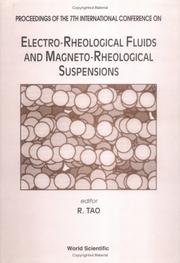
ISBN: 9812793607 9789812793607 9810242581 9789810242589 Year: 2000 Publisher: Singapore ; River Edge, NJ : World Scientific,
Abstract | Keywords | Export | Availability | Bookmark
 Loading...
Loading...Choose an application
- Reference Manager
- EndNote
- RefWorks (Direct export to RefWorks)
Electrorheological (ER) and magnetorheological (MR) fluids, which can be transformed from the liquid state into the solid state in milliseconds by applying an electric or a magnetic field, are smart fluids having the potential to revolutionize several industrial sectors. The Seventh International Conference on Electrorheological Fluids and Magnetorheological Suspensions took place at a time when some MR and ER applications were beginning to appear on the market, making a notable impact on industries. Scientists and engineers in multidisciplinary areas came together to explore the state-of-the-art technology and identify thrust areas to be focused on. This volume of proceedings collects contributions from most leading experts in the field. It reviews the most recent MR and ER applications, discusses the materials technology, explores the basic science research on ER and MR fluids, and examines the novel properties of these fluids. It provides the most up-to-date and probably the best information about the area. It can serve as a stimulating and valuable reference for research workers and students in materials science, condensed matter physics, engineering, and chemistry. The valuable information not only reports on the leading edge of research and applications, but also provides an overview of the field.
Electrorheological fluids --- Materials --- Engineering --- Engineering materials --- Industrial materials --- Engineering design --- Manufacturing processes --- ER fluids --- Fluids --- Rheology --- Electric properties --- Magnetic properties
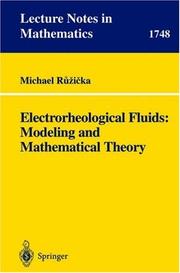
ISBN: 3540413855 3540444270 9783540413851 Year: 2000 Volume: 1748 Publisher: Berlin: Springer,
Abstract | Keywords | Export | Availability | Bookmark
 Loading...
Loading...Choose an application
- Reference Manager
- EndNote
- RefWorks (Direct export to RefWorks)
This is the first book to present a model, based on rational mechanics of electrorheological fluids, that takes into account the complex interactions between the electromagnetic fields and the moving liquid. Several constitutive relations for the Cauchy stress tensor are discussed. The main part of the book is devoted to a mathematical investigation of a model possessing shear-dependent viscosities, proving the existence and uniqueness of weak and strong solutions for the steady and the unsteady case. The PDS systems investigated possess so-called non-standard growth conditions. Existence results for elliptic systems with non-standard growth conditions and with a nontrivial nonlinear r.h.s. and the first ever results for parabolic systems with a non-standard growth conditions are given for the first time. Written for advanced graduate students, as well as for researchers in the field, the discussion of both the modeling and the mathematics is self-contained.
Electrorheological fluids --- Mathematical models. --- Mathematical Theory --- Atomic Physics --- Mathematics --- Physics --- Physical Sciences & Mathematics --- Mathematical models --- Fluid mechanics --- Fluides, Mécanique des --- Mathematics. --- Fluid mechanics. --- Fluids. --- Partial differential equations. --- Engineering Fluid Dynamics. --- Fluid- and Aerodynamics. --- Partial Differential Equations. --- Partial differential equations --- Hydraulics --- Mechanics --- Hydrostatics --- Permeability --- Hydromechanics --- Continuum mechanics --- Équations aux dérivées partielles --- Mécanique des fluides. --- Electrorheological fluids - Mathematical models. --- Équations aux dérivées partielles --- Mécanique des fluides.
Book
ISBN: 9783319132334 3319132326 9783319132327 3319132334 Year: 2015 Publisher: Cham : Springer International Publishing : Imprint: Springer,
Abstract | Keywords | Export | Availability | Bookmark
 Loading...
Loading...Choose an application
- Reference Manager
- EndNote
- RefWorks (Direct export to RefWorks)
This book deals with magnetorheological fluid theory, modeling and applications of automotive magnetorheological dampers. On the theoretical side a review of MR fluid compositions and key factors affecting the characteristics of these fluids is followed by a description of existing applications in the area of vibration isolation and flow-mode shock absorbers in particular. As a majority of existing magnetorheological devices operates in a so-called flow mode a critical review is carried out in that regard. Specifically, the authors highlight common configurations of flow-mode magnetorheological shock absorbers, or so-called MR dampers that have been considered by the automotive industry for controlled chassis applications. The authors focus on single-tube dampers utilizing a piston assembly with one coil or multiple coils and at least one annular flow channel in the piston.
Engineering. --- Engineering Fluid Dynamics. --- Machinery and Machine Elements. --- Automotive Engineering. --- Hydraulic engineering. --- Ingénierie --- Technologie hydraulique --- Hydraulics. --- Civil & Environmental Engineering --- Engineering & Applied Sciences --- Civil Engineering --- Electrorheological fluids. --- Magnetic suspension. --- Magnetic levitation --- Suspension, Magnetic --- ER fluids --- Fluid mechanics. --- Machinery. --- Automotive engineering. --- Fluids --- Rheology --- Magnetics --- Construction --- Industrial arts --- Technology --- Engineering, Hydraulic --- Engineering --- Fluid mechanics --- Hydraulics --- Shore protection --- Machinery --- Machines --- Manufactures --- Power (Mechanics) --- Mechanical engineering --- Motors --- Power transmission --- Hydromechanics --- Continuum mechanics --- Curious devices
| Listing 1 - 10 of 10 |
Sort by
|

 Search
Search Feedback
Feedback About UniCat
About UniCat  Help
Help News
News